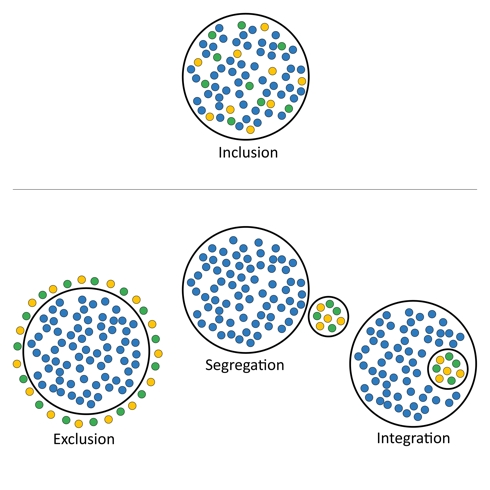About Inclusive Education
“Inclusive communities start with inclusive neighbourhood schools that value diversity and respect the right of ALL students to be welcomed and to belong.”1
What is inclusive education?
Inclusive education means that children and young people from ALL social, cultural, community and family backgrounds, and of all identities and all abilities are able to:
- Attend and be welcomed by their local school
- Access and participate fully in a high-quality education
- Learn and engage in the same curriculum and all other aspects of school life alongside similarly-aged peers
- Learn in a safe and supportive environment free from bullying, harassment or discrimination and
- Achieve academically and socially with support and adjustments that are tailored to meet the individual strengths and needs of every student.
Inclusive education is:
- A human right
- Best for everyone
- Based on evidence
- Supported by law2
Inclusive education is a human right
The right to access a quality inclusive education is encompassed in Article 24 of the United Nations Convention on the Rights of Persons with Disabilities (UNCRPD), to which Australia is signatory.3
General comment No. 4 of the UNCRPD refers to inclusive education as:
a) A fundamental human right of all learners. Notably,
education is the right of the individual learner, and not, in the case of children, the right of a parent or caregiver. Parental responsibilities in this regard are subordinate to the rights of the child.
b) The result of a process of continuing and pro-active
commitment to eliminate the barriers impeding the right to education, together with changes to culture, policy and practice of regular schools to accommodate and effectively include all students.4
Evidence for inclusive education
The case for inclusive education over ‘special education’ models is strong and is evidenced by four decades of research showing that when students living with disability are included, all students learn and achieve more. Children living with disability perform better on all measures and benefit academically, socially and emotionally from education in regular classrooms in the general education system rather than segregated, disability-specific settings.5
“There is clear and consistent evidence that inclusive educational settings can confer substantial short- and long-term benefits for students with and without disabilities.”6
An inclusive education gives every student the best chance of lifelong wellbeing and happiness, as well as success later in life.
Inclusive education differs from other approaches
Inclusion is embedded in all aspects of school life and not only teaching practice, including culture, policies and every day practices.7
“The central message is simple: every learner matters and matters equally.”8
Inclusive education differs from exclusion, segregation or integration, as specified in General comment No. 4:
- Exclusion occurs when students are directly or indirectly prevented from or denied access to education in any form.
- Segregation occurs when the education of students with disabilities is provided in separate environments designed or used to respond to a particular or various impairments, in isolation from students without disabilities.
- Integration is a process of placing persons with disabilities in existing mainstream educational institutions, as long as the former can adjust to the standardized requirements of such institutions.9

Figure 1 Infographic for inclusion, exclusion, segregation and integration approaches
References
1. All Means All (no date), For parents – Why include?, http://allmeansall.org.au/for-parents/
2. Community Resource Unit (2018), What is inclusive education?, Education fact sheet 1, http://cru.org.au/wp-content/uploads/2018/11/Fact-Sheet-1-WHAT-IS-INCLUSIVE-EDUCATION.pdf
3. UN General Assembly, Convention on the Rights of Persons with Disabilities, Article 24 General Comment No. 4
4. Ibid
5. Family Advocacy (2018), Same classroom same opportunities, Briefing Paper, p. 3.
Hehir, T et al. (2016), A summary of the evidence on inclusive education, Instituto Alana, pp. 3, 4.
6. Hehir, T et al. (2016), A summary of the evidence on inclusive education, Instituto Alana, p. 2.
7. Ibid.
8. United Nations Educational Scientific Cultural Organisation (UNESCO) (2017), A guide for ensuring inclusion and equity in education, p. 12, http://unesdoc.unesco.org/images/0024/002482/248254e.pdf
9. UN General Assembly, Convention on the Rights of Persons with Disabilities, Article 24 General Comment No. 4
Inclusive School Communities Project
Phone: (08) 8373 8333
Email: admin@purpleorange.org.au
Address: 104 Greenhill Road, Unley SA 5061